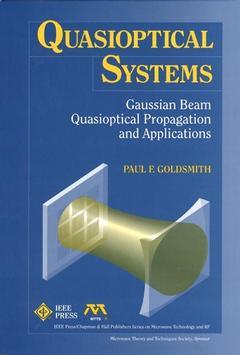Quasioptical Systems Gaussian Beam Quasioptical Propogation and Applications IEEE Press Series on RF and Microwave Technology Series
Auteur : Goldsmith Paul F.

ACKNOWLEDGMENTS.
Chapter 1: Introduction and Historical Overview.
1.1 What Is Quasioptics?
1.2 Why Quasioptics Is of Interest.
1.3 Historical Overview.
1.4 Organization of This Book.
1.5 Bibliographic Notes.
Chapter 2: Gaussian Beam Propagation.
2.1 Derivation of Basic Gaussian Beam Propagation.
2.2 Description of Gaussian Beam Propagation.
2.3 Geometrical Optics Limits of Gaussian Beam Propagation.
2.4 Higher Order Gaussian Beam Mode Solutions of the Paraxial Wave Equation.
2.5 The Size of Gaussian Beam Modes.
2.6 Gaussian Beam Measurement.
2.7 Inverse Formulas for Gaussian Beam Propagation.
2.8 The Paraxial Limit and Improved Solutions to the Wave Equation.
2.9 Alternative Derivation of the Gaussian Beam Propagation Formula.
2.10 Bibliographic Notes.
Chapter 3: Gaussian Beam Transformation.
3.1 Introduction.
3.2 Ray Matrices and the Complex Beam Parameter.
3.3 Gaussian Beam Transformation by Focusing Elements.
3.4 Mode Matching.
3.5 Complex Beam Parameter and Smith Chart Representation.
3.6 Transformation of Higher Order Gaussian Beam Modes.
3.7 Bibliographic Notes.
Chapter 4: Gaussian Beam Coupling.
4.1 Introduction.
4.2 Axially Aligned Beams.
4.3 Tilted Beams.
4.4 Offset Beams.
4.5 Bibliographic Notes.
Chapter 5: Practical Aspects of Quasioptical Focusing Elements.
5.1 Introduction.
5.2 Single-Pixel and Imaging Systems.
5.3 The Eikonal Equation.
5.4 Refractive Focusing Elements.
5.5 Zoned Lenses.
5.6 Zone Plate Lenses.
5.7 Metallic Lenses.
5.8 Reflective Focusing Elements.
5.9 Bibliographic Notes.
Chapter 6: Gaussian Beams and Antenna Feed Systems.
6.1 Introduction.
6.2 Antenna Efficiency and Aperture Illumination.
6.3 Aperture Efficiency.
6.4 Radiation Patterns.
6.5 Extended Sources.
6.6 Defocusing Due to Secondary Motion in Cassegrain Systems.
6.7 Requirements on the Beam Waist.
6.8 Reflection Due to Central Blockage in Cassegrain Systems.
6.9 Bibliographic Notes.
Chapter 7: Gaussian Beam Coupling to Radiating Elements.
7.1 Introduction.
7.2 Expansion in Gaussian Beam Modes: General Considerations.
7.3 Radius of Curvature.
7.4 Beam Radius.
7.5 Beam Waist Location and Complex Amplitudes.
7.6 Gaussian Beam Modes for Feed Elements of Various Types.
7.7 Summary of Fundamental Mode Coupling Coefficients.
7.8 Bibliographic Notes.
Chapter 8:Frequency-Independent Quasioptical Components.
8.1 Introduction.
8.2 Path Length Modulators/Delay Lines.
8.3 Polarization Processing Components.
8.4 Polarization Transducers and Wave Plates.
8.5 Quasioptical Hybrids.
8.6 Quasioptical Attenuators and Power Dividers.
8.7 Quasioptical Ferrite Devices.
8.8 Quasioptical Absorbers and Calibration Loads.
8.9 Bibliographic Notes.
Chapter 9: Quasioptical Frequency-Selective Components.
9.1 Introduction.
9.2 Planar Structures.
9.3 Thick Structure: Perforated Plates.
9.4 Interferometers.
9.5 Interferometers of Other Types.
9.6 Layered Dielectrics.
9.7 Multiple-Grid Filters.
9.8 Diffraction Gratings.
9.9 Resonators.
9.10 Bibliographic Notes.
Chapter 10: Quasioptical Active Devices.
10.1 Introduction.
10.2 Bulk Coupled Quasioptical Devices.
10.3 Quasioptical Planar Arrays.
10.4 Cavity-Coupled Quasioptical Devices.
10.5 Spatial Power Combining.
10.6 Bibliographic Notes.
Chapter 11: Quasioptical System Design: Principlesand Examples.
11.1 Introduction.
11.2 Design Methodology and General Guidelines.
11.3 System Design Examples.
11.4 Conclusions.
11.5 Bibliographic Notes.
BIBLIOGRAPHY.
INDEX.
ABOUT THE AUTHOR.
Date de parution : 01-1998
Ouvrage de 432 p.
18.5x26.3 cm
Thème de Quasioptical Systems :
Mots-clés :
wavelengths; remote; commercial use; quasioptical; sensing; engineering; millimeter; propagation; beam; gaussian; electrical; new lowcost; need; quasioptical systems; advantages; broader bandwidth; insertion; purity; book



